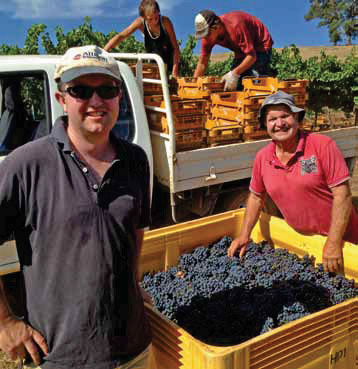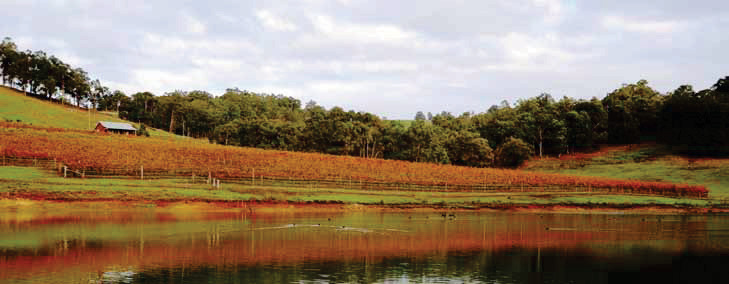By Sonya Logan
First published in the September/October 2013 issue of the Wine & Viticulture Journal

 The 2013 edition of The Australian & New Zealand Wine Industry Directory lists 20 Australian wineries that currently crush the Portuguese variety Tinta Cao. Small family producer Mazza Wines, in Western Australia’s Geographe region, is one of the few who is making a straight varietal out the grape, which translated means ‘red dog’.
The 2013 edition of The Australian & New Zealand Wine Industry Directory lists 20 Australian wineries that currently crush the Portuguese variety Tinta Cao. Small family producer Mazza Wines, in Western Australia’s Geographe region, is one of the few who is making a straight varietal out the grape, which translated means ‘red dog’.
It took five years for David Mazza to find the perfect spot to plant his vineyard. Drawn to Western Australia’s Geographe region where he had grown up near his grandparents’ property on which a few vines were tended and made into wine each year using the traditional foot-stomping method, David had a few prerequisites: good soil and water, a north-facing slope and some gentle undulation.
A patch of dirt near Donnybrook eventually fit the bill, and in 2002 David and his family set about planting four acres of vines. But it wasn’t the customary French varieties that David had earmarked for this vineyard. Rather, it was a handful of Iberian varieties, particularly those from Rioja and the Douro Valley, which had caught his attention while living in the UK for several years in the 1990s.
“We used to travel to Spain and particularly Portugal quite a bit,” David recalls of his years while a short flight from the Iberian Peninsula. “This was around the time Portuguese producers were in the process of converting a lot of their production from Port to table wines. We really quite liked them.
They were very fruit-driven.”
So, in his original four acre vineyard David planted six Spanish and Portuguese winegrape varieties: Tempranillo, Graciano, Touriga Nacional, Tinta Cao, Bastardo and Sousao. In 2008, an additional six acres were planted to Bastardo and Touriga Nacional. The Mazzas believe their vineyard is the only one in Australia to have this collection of varieties on a single site.
Just a third of an acre– or two rows – is planted to Tinta Cao in their now 10-acre vineyard, which is largely grown on heavy chocolate loams, with smaller areas of red loam with quartz.

Like the rest of the vineyard, the Tinta Cao rows are planted roughly east-west and trained to a VSP, with most of the fruit grown on the northern side of the canopy.
“On the south side, we leave a lot foliage. We get very hot summers. From veraison in December, it’s usually pretty hot. We’re unlikely to get anything under 32°C until after we pick and in January we usually get a week of 40oC. And, because we don’t get coastal breezes to help cool things down, we have to protect the fruit in the afternoon. We haven’t seen any burnt fruit yet.”
Vines in the Mazza vineyard are planted two metres apart, while there is 3.6m between rows. David admits this row spacing is “pretty wide”, but the aim is to allow as much light to reach the fruit as possible.
David described Tinta Cao as having a “reasonably upright” growth habit.
“The canes are quite wiry, unlike Tempranillo which can be very brittle when you try to train it. Tinta Cao and Touriga are very flexible by comparison.”
He said the foliage of the Tinta Cao appeared quite yellow during the first couple of years. While he initially suspected disease was at play, he soon learned the discolouration was normal for the variety.
“Tinta Cao is a big vine and, therefore, needs a robust trellis. It produces relatively small and spare bunches. It’s not a particularly packed bunch and it’s fantastic fruit to eat.”
Excluding the Sousao and Graciano, shoot thinning and leaf plucking is carried out across the Mazza vineyard each year, the latter to provide even bunch ripening. Fruit thinning, however, is rare unless it appears the vines are working too hard.
“We try and push the boundaries of how much water we give the vineyard. If the vines start to wilt we’ll give them water. We find Tinta Cao and Tempranillo are fairly early indicators of water stress. We pick in mid-March so we’ll turn the water on mid-January.”
Although the vineyard can experience heavy easterlies, due to the east-west orientation of the rows, David says these winds tend to blow down the rows and so pose no real threat to the vines themselves.
“Tinto Cao is relatively disease-resistant,” he said. “It gets a bit of powdery but only in exceptional years when it gets quite humid in December. It’s not as susceptible as Tempranillo though.”
Until 2007, when production of the other varieties in the vineyard came up, Mazza Wines only produced a Tempranillo. Today it produces six wines – a Rose Bastardo, Tempranillo, Graciano, Touriga Nacional, a blend of Sousao/Graciano/Touriga Nacional/Tinta Cao/Tempranillo and, of course, a Tinta Cao – which are made by a couple of contract winemakers.
“For the first couple of years, the Tinta Cao was very acidic. Then the vines settled down. The wine still has a significant acid level to it but it’s not so predominant now. The wine is quite smooth, and gives you a big mouthful of red berries. There’s a lot of colour in Tinta Cao too. It’s a pretty deep colour despite spending little time on skins.”
David picks his Tinta Cao at 14.5Be.
“It needs to be ripe to get flavour out of the grapes. Although that makes a wine that is quite high in alcohol, it’s not predominant. We did pick one year at 13Be but it was way too acidic; we ended up tipping it out.”
Although David says Tinta Cao can crop higher, he restricts his yields of the variety to 3-4 tonnes per acre.
“Up until now, we’ve only been producing 25 cases of Tinta Cao a year but this year we’ll make 50 cases. That’s not a huge amount but I think that’s the highest production we’re going to get on this site. We would like to expand but that’s a little way down the track.”
The Mazza Wines Tinta Cao spends around six months in oak – old, usually French wood – before being bottled ready for sale. Mazza Wines has a small distribution in a handful of restaurants and four retail outlets in Perth but most sales are direct to customers via its website (www.mazza.com.au) where the Tinta Cao can be purchased for $25.00 a bottle when purchased in 12-bottle case.
TINTO CÃO

By Peter Dry, Emeritus Fellow, The Australian Wine Research Institute
Background
Tinto Cão (TEEN-toh KAY-oh) is an old variety from northern Portugal, known since the 17th century. Globally there were 369 ha in 2010 (down 34% from 2000), close to 100% in Portugal, mainly in the Douro, with a lesser area in the Dão. New plantings have been made in Estramadura and Setubal. Tinto Cão is considered to be one of the most important varieties in the Douro for port, both for quality and contribution to the blend but it has never been widely planted—probably because of low yield. Today it is also used in blended red wines from Douro and Dão. Synonyms are Farmenta and Tinta Cão. According to recent DNA research, it could be related to both Viosinho and Tinta Francisca. It is also one of the parents of the red-juiced Rubired. There is a very small area of Tinto Cão in California. In Australia it is used for port-style and table wines with currently at least 22 wine producers in WA, SA, Vic. and NSW. In 2015, there were 10 ha in SA.
Viticulture
Budburst is mid-season and ripening is late. Bunches are small, loose and berries are medium, dark-blue or black with thick skin and heavy bloom. Vigour is high and growth habit is semi-erect. In Portugal yield is said to be low and uniform. Bud fertility is good and spur pruning can be used although cane pruning is most common in Portugal. It is sensitive to drought but tolerant of heat with low susceptibility to sunburn. Harvest can be fully mechanized. It is tolerant of Botrytis bunch rot due to its loose bunch and tough skin but has moderate susceptibility to powdery and downy mildews.
Wine
Quality is variable: good if fruit can achieve full ripeness (at least 13.5 to 14.0°Brix). Such wines have moderate colour, medium to high acidity, blackcurrant and strawberry fruits with well rounded tannins. Inadequate maturity inevitably leads to thin wines with poor colour and vegetative characters. This variety does not achieve high quality every year in the Douro. It is much better suited to blending than to varietal wine.













